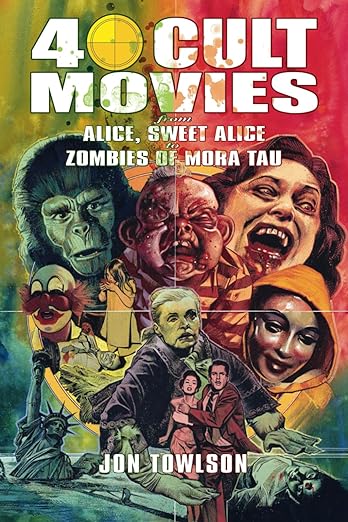40 Cult Movies: from Alice Sweet Alice to The Zombies of Mora Tau by Jon Towlson
“Why do we like these movies so much?” It’s a question author Jon Towlson asks in the introduction to this book as he reflects on his own tastes, which – to go by his writing career to date, as much as by his avowals here – have tended towards what we call ‘cult film’: horror, sci-fi, fantasy, arthouse, or all shades thereof. It’s an interesting question, too, from the perspective of, err, Warped Perspective, which almost exclusively covers material of the same stripe. And the question’s answered here, not just in a warm, impassioned intro, but in the main body of the book – this being a series of forty essays on a wide range of films, linked together by their weird and wonderful, cult film qualities. Some of the titles included are very well-established, whilst others are scarcely known; the book gives us a chance to either reconsider them, or in some cases, to effectively introduce them. And that’s a good thing: where the titles discussed were less familiar to me, I felt as though I’d had a very interesting conversation with a fan pointing out a range of good reasons for me to seek that title out.
The films under discussion span 1932-2009, though clustering in the main around the 70s and 80s (a point in time when film had enough of a sense of itself to reflect on things like genre and audience, whilst also being able to exploit new developments and possibilities within filmmaking). The approach taken in each of the essays (arranged alphabetically) is not simply to cover the content of each film. Sometimes that is discussed, but more from the point of view of identifying interesting aspects or context. For the most part, these essays look at how a particular screenplay emerged out of a raft of successful, ground-breaking or shocking films of a similar nature, how directors and writers were shaped by social and cultural phenomena going on around them, or how the film reflected particular genre features (‘urbanoia’, body horror, Gothic). Something that’s often discussed, too, is how certain films were received at the time: that can be a real eye-opener, as we can tend to assume that certain titles have always been well-loved, but actually the route to being a fan favourite can be a bit of a rocky one…
Following on from this, there’s a wealth of research here on critical response, with extensive mention made of contemporary reviews and reviewers – there must have been a lot of time-consuming hard graft in chasing all of this research down. Critical commentary is embedded well and, by the by, not all of this critique agrees with other critique, so you get a broad range of often contrasting opinions. Towlson is not necessarily here to pull any of this critique apart, as this would make for a very different book – however, a good deal of his own thoughts and opinions are given quite obliquely rather than head-on, as the book is mainly focused on what makes these films interesting, rather than a straightforward tussle about what makes them good. Besides, a lot of his critical opinion really takes place beyond the margins of the book itself, and is in the array of titles he has chosen to include in the first place.
There are some brilliant and thought-provoking inclusions throughout the book which would fall into the ‘that’s very interesting’ category; here are some of them, but by no means all. Towlson discusses the relationship between The Blair Witch Project/found footage and the epistolary novel; the origins of the ‘Horror Western’ with Curse of the Undead in ’59 (though it goes back even further); details from the alternative script of Day of the Dead; the developments to Chinese jiangshi folklore in Mr Vampire, oh and the revelation that, after making Shivers, David Cronenberg was evicted from his apartment on a ‘morality clause’! He later got his revenge…
This is an engaging collection of film essays which don’t follow a set formula, instead picking up on whatever is particularly worthy of exploration in each case. This helps to make the book varied, and one to either devour in one or two sittings, or two dip into here or there (the inclusion of a thorough index makes it potentially very useful for research, too). It strikes a great balance between specialist knowledge and ardent fandom, and it’s a nicely-arranged, attractive book which would make a good addition for any cult film fan’s bookshelf.
You can pick up a copy of 40 Cult Movies, and any of Jon’s other books, here.
